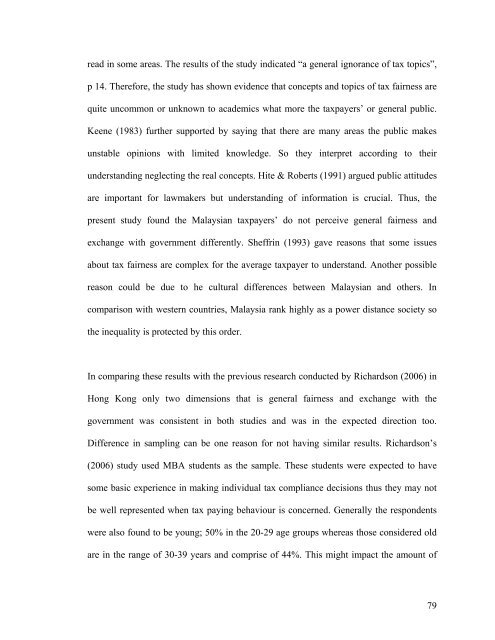1 CHAPTER 1: INTRODUCTION 1.0 Chapter ... - DSpace@UM
1 CHAPTER 1: INTRODUCTION 1.0 Chapter ... - DSpace@UM
1 CHAPTER 1: INTRODUCTION 1.0 Chapter ... - DSpace@UM
You also want an ePaper? Increase the reach of your titles
YUMPU automatically turns print PDFs into web optimized ePapers that Google loves.
ead in some areas. The results of the study indicated “a general ignorance of tax topics”,p 14. Therefore, the study has shown evidence that concepts and topics of tax fairness arequite uncommon or unknown to academics what more the taxpayers’ or general public.Keene (1983) further supported by saying that there are many areas the public makesunstable opinions with limited knowledge. So they interpret according to theirunderstanding neglecting the real concepts. Hite & Roberts (1991) argued public attitudesare important for lawmakers but understanding of information is crucial. Thus, thepresent study found the Malaysian taxpayers’ do not perceive general fairness andexchange with government differently. Sheffrin (1993) gave reasons that some issuesabout tax fairness are complex for the average taxpayer to understand. Another possiblereason could be due to he cultural differences between Malaysian and others. Incomparison with western countries, Malaysia rank highly as a power distance society sothe inequality is protected by this order.In comparing these results with the previous research conducted by Richardson (2006) inHong Kong only two dimensions that is general fairness and exchange with thegovernment was consistent in both studies and was in the expected direction too.Difference in sampling can be one reason for not having similar results. Richardson’s(2006) study used MBA students as the sample. These students were expected to havesome basic experience in making individual tax compliance decisions thus they may notbe well represented when tax paying behaviour is concerned. Generally the respondentswere also found to be young; 50% in the 20-29 age groups whereas those considered oldare in the range of 30-39 years and comprise of 44%. This might impact the amount of79
















